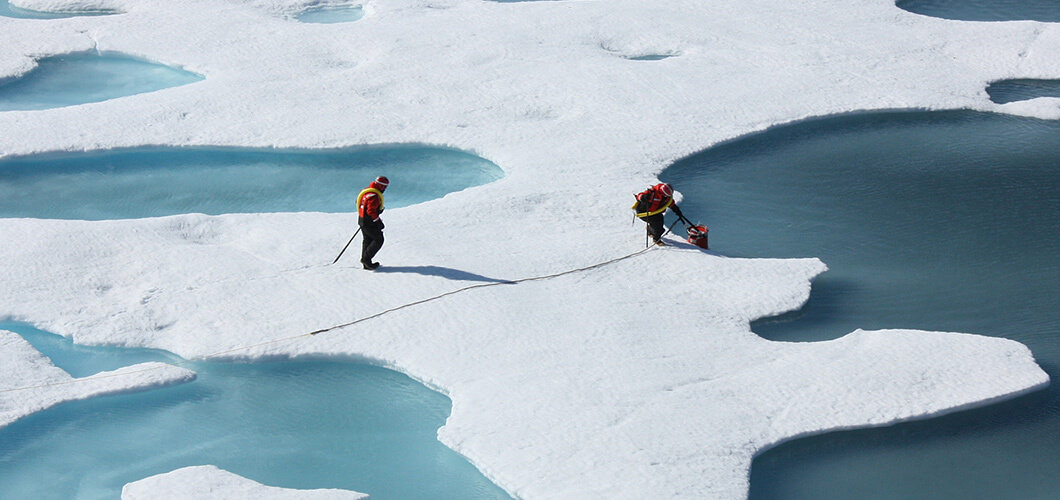What Happens if The Polar Ice Caps Melt
No ice, no dice: welcome to the water world
Video of the day August 24th 2019
From its affect on the land, to its effect on all life on Earth, join us as we reveal to you what would happen if all the ice on the Earth melts.
10. Proves Global Warming Is Real
Believe it or not, there are some people in the world right now that still don’t believe Global Warming is a thing, even though it’s been proven time and time again in a variety of ways. And Global Warming is honestly a major factor in why the ice caps are melting.
Now to say it’s the only factor would be a bit of a lie, because as in all things in life, there are many causes and effects that cause various things to happen. But, there’s no doubt in many people’s minds that the atmosphere of the Earth if heating up because of carbon emissions put up there by humanity via buildings, cars, etc.
While the process is slow, there is a raise in the temperature of the Earth, and when it comes to temperature, there is such a thing as a “delicate balance”. If things are too cold, they’re freeze, and when they’re too warm, they’ll potentially melt. And in the northern regions of the world especially, that balance isn’t what it should be, thus, the polar ice caps are melting. It’s slowly, but it is getting more and more noticeable.
And it’s only going to compound every single year until the temperature is restored or something else happens. The only real question is, are we going to have to wait that long to understand what’s happening to the planet?

9. Rising Sea levels
Without a doubt, one of the biggest worries when it comes to the polar ice caps melting is the question of what they’ll do to the natural bodies of water in the world. Meaning, the oceans that the ice caps mostly inhabit. Ironically enough, from the point of 1801-1900, the ocean did rise on its own, but only by about 2 inches. This is important to note because this was before the true rise of the internal combustion engines, and thus gas emissions by the human race weren’t as massive as they are now. So this proves that there are many factors that lend to what is going on in the world.
However, in contrast, from 1901-2000, the oceans rose 7.5 inches. Which means over the course of 100 years, humanity tripled what the world did on its own in terms of making the oceans rise. And certain scientific organizations state that if this progress continues, added on with the now truly massive amounts of greenhouse gases pumped into the atmosphere, that the oceans could rise up to over 8 feet in height by the year 2100.
So while a few inches may not seem that significant in the long run of things, it’s hard to deny that the oceans rising several feet is a very bad thing. But, you could also argue that even a few inches of raising is bad in the long term of things.
8. The Loss Of Islands
There are many ways to define parts of the world, but one of the most important parts that people forget about is “above sea level”. Meaning how far you are in height from the nearest source of major water like an ocean. What most people don’t realize is that the elevation you are at is sometimes hard to predict or feel because of the curvature of the Earth itself. So sometimes people are hundreds of feet above sea level, yet you don’t feel it because it doesn’t affect your body like you would if you were on a mountain or higher plateau.
However, that being said, there are many places that are right smack dab on the line between land and ocean, and so if the ocean were to rise even a few inches, it would affect them heavily. And then should it rise up a few feet? That would cause all sorts of problems.
This is extremely plausible for certain island nations that exist in the world today. For example, should the waters rise to 8 feet or higher than where they are now, the nations of the Maldives, Marshall Islands, Kiribati, and Tuvalu will literally be drowned beneath the surface. As they’re right on the sea level. In the case of the Maldives, they actually pride themselves on being right on the bluest parts of the ocean and not having a massive land mass around them for 100 miles.
And let’s not forget about certain other places that do have slightly higher elevations than them. Places like Hawaii, Japan, the Caribbean, and more would have their lands enveloped by the rising water tides. They won’t be fully submerged, but they’ll lose a lot of land mass, and that would cause many problems. Including…
7. Transplanting
So the loss of land of any kind is a very bad thing. But what you might forget in the shock of that is that there are people who live in those areas that will have lost their homes, jobs, and potential histories in the rising waters caused by the melted polar ice caps. And every single one of them…will need a new place to go.
According to predictions, should the waters rise like they’re expected to, by 2050, there will be 150 million people needing a new home because of these events. That’s a lot of people, and more than likely a lot more than you were expecting to see here, right? But that’s not the worst of it, if the 8 feet of rising waters happen like it’s expected to by 2100, that number is expected to be closer to 2 billion people. Which at present it close to 1/4 of the Earth’s population as it stands right now.
This would be a major problem for all sorts of reasons. Not the least of which is that it’s not feasible to just take the people and dump them some place in the world. The rising water levels will affect all nations that border the oceans, and thus will cut back a lot of the living space that is available.
Now sure, if there is enough planning, and the right steps are taken, measures can be made to support these refugees. And it’s also possible that we can curb the rising water levels if certain things are achieved. But this is very much a “we need to fix this now” kind of issue. The more this gets delayed, the more potential danger the world, and its people, are in.
Plus, if the transplanting initiative doesn’t get started when the nations started to get drowned out, we’ll have an overpopulation problem in key areas, and that won’t benefit anyone.

6. The Worst Case Scenario
I know what you’re thinking, “wait, it can get worse than that?” Yeah, it can. Remember, the last few estimates that we made were JUST for the waters raising the 8 feet that is EXPECTED to happen over the course of the nest 80+ years or so. But that’s not all the ice caps melting, that’s just the progression of them.
So, what WOULD happen if all the ice caps melt? Nothing good, that’s for sure. But despite what some people believe, even if many of the major ice cap areas of the world melted fully, we would NOT living in a Waterworld, sorry Kevin Costner.
In rough estimates, if all the glaciers on Earth, mixed with the combined ice of Greenland and Antarctica melted fully, it would raise the water levels of Earth over 200 feet. Which is WELL over what the 8 feet we’ve been talking about is. And just like before, it would cause all sorts of changes to the maps of the world. Cities like San Diego, Portland, and others on the Western Coast of the United States would be either fully or partially underwater.
Sticking with California, certain areas of land would go from land masses, to islands, and other would be utterly wiped out because of the new natural state of the ocean surface via waves, tides, currents, etc.
Oh, but that’s just the west coast of the US.
5. East Coast Problems
Want to know what’ll happen to the eastern side of the United States? Because of its relationship with the Atlantic Ocean, should all the ice caps melt, we would lose a slew of cities. Not the least of which is Houston and New Orleans (which makes sense when you realize how badly hurricanes can affect those cities as proven in past years). New York, Boston, Long Island, Washington D.C. and many more would be heavily affected.
But that’s not all, we wouldn’t just lose cities, we’d lose states! Both Florida and Delaware would be drowned entirely if the oceans raised over 200 feet. Try and picture that if you will, losing entire states and going to where the new “coastlines” are and realizing that there used to be a lot of people who lived there at one time.
And that’s just one nation, let’s talk about the world impact of such things.
4. A Drowned World
In South America, the 220+ feet of rising water would heavily affect all sides of the continent (as they border both the Pacific and Atlantic Oceans. The northern side would gain a great deal of water and thus permanently alter the shape of South America as a whole. And in terms of losses, they would lose Rio De Janeiro, Buenos Aires and Montevideo to the waters. Among others of course.
Then there’s Europe, which arguably gets the worst of it because of its shape and how many of its nations and cities are close to or are on the edge of the Atlantic and Arctic Oceans.
The Netherlands would be totally drowned, and a vast majority of Denmark would be as well. Belgium would lose half of its lands to the waters too. Germany would lose its entire northern half to the waters of the ocean and even lose Berlin in the process.
Heading to the UK, the once glorious nation would now look like a string of islands instead of a solid nation. And its most prized city, London, would be gone.
Other losses would include Venice, Italy, Istanbul, Cairo, and Alexandria. Ironically, Africa wouldn’t be very much affected, but it would still take losses. Asia would be alright for the most part as it’s mostly inland, but China, Japan, Korea, would be heavily affected, Bangladesh would be gone, and many key cities of the world today would vanish.
All in all, this would be a very bad thing. Although, there is one very small bright side to this worst case scenario.
3. The Antarctica Solution
Remember how I mentioned that the 200+ feet of water rising would have to include Antarctica melting? Well that’s the thing, the continent is still a land mass, it’s just one that is so cold that it has a massive layer of permafrost on it and it’s freezing temperatures make hard to colonize. Unless you’re a cold-weather animal that is.
Yet, if the polar ice caps melt, and Antarctica’s ice goes with it…that actually means there’s a lot of land out there to be colonized. In theory, anyway. There have been clues in the past that state that Antarctica has been colonized before its massive freezing, and this event could allow for people to try and go there. And given the size of Antarctica, if enough land remained, it could help be a new region for the many displaced people of the new watery world to inhabit.
It’s not a permanent solution, and there are bound to be issues, but considering all the bad that would’ve happened to the world at that time, it would be nice to see a new land to inhabit being reborn as it where.
2. Human Status Quo
Lost in all of this is that should the world flood heavily like this, regardless of it being the possible scenario or the worst case scenario, there’s one thing that is undeniable. And that is simply that humanity will have a lot to do in order to fight off the new status quo.
By that, I mean that in the worst case scenario, many key places and establishments in the world today would be gone. Including major places of industry, agriculture, history, and just plain life. While we’ve already talked about the transplanted people, it also needs to be said that without many of these cities, there’s going to be a lot of people seeking jobs. Ones that were popular in places like Los Angeles, Tokyo, London, Berlin. Some of these places were industry leaders in technology, entertainment, industry, and more. Some other city will have to pick up the slack for that.
As for the agriculture side of things, this would heavily affect the food of the world, and could even cause a shortage of sorts that’ll drastically affect people in many areas. Add to that,certain electrical buildings, treatment areas,hospitals,and more will need to be rebuilt in various new areas
A watered down world is going to affect people in a lot of ways many don’t expect. And they won’t be the only ones affected.
1. Animal Status Quo
Forgot about the creatures of the world, huh? Well if various parts of the world (inhabited by humans or not) are drowned, the animals are going to need a new place to live as well. What’s more, they’re natural instincts will inform them that something is wrong, and warn them that they need to move on. But move on to where?That’s the problem.
Animals live in a natural balance with the environment. Their ecosystems are built upon many things, and if that balance is thrown off, all of them are affected. For example, if a predator from one area in the north near an ocean is forced to move to an area south it’s never lived before, that’s a new factor that the other animals and plants in the ecosystem are going to have to adapt to. And that’s not always easy.
Not to mention, there will be other animals who CAN’T move because of their bodies, habitats, etc. So there is more than likely a chance that many plants and animals will go extinct because of this extreme flooding.
If that happens, it could affect the world at large in seen and unseen ways. Including affecting human cities as they try and flee to new habitats.
subscribe to the insane curiosity channel
Insane Curiosity is a channel of astronomy, physics and future technology, which teach mostly about Space, Recent Space Discoveries/News, Future Events, The Solar System, Exoplanets, Mars, Colonization Plans, etc.). We prepare New videos almost every day. Learn With us and Stay Insanely Curious!

Subscribe For the Latest news & Updates
Subscribe For the Latest news & Updates
Get in touch with the Insane Curiosity Channel. Once in while you will receive emails about news, promos, and much more. Stay Tuned!
Insane Curiosity
Science made easy
All rights reserved
Who we are
Insane Curiosity is a channel of astronomy, physics and future technology, which easily explain science. We need science and science need us!

